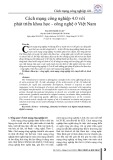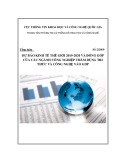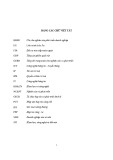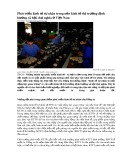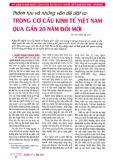
http://www.iaeme.com/IJM/index.asp 67 editor@iaeme.com
International Journal of Management (IJM)
Volume 8, Issue 5, Sep–Oct 2017, pp. 67–80, Article ID: IJM_08_05_008
Available online at
http://www.iaeme.com/ijm/issues.asp?JType=IJM&VType=8&IType=5
Journal Impact Factor (2016): 8.1920 (Calculated by GISI) www.jifactor.com
ISSN Print: 0976-6502 and ISSN Online: 0976-6510
© IAEME Publication
EVOLUTION OF INDIAN MODERN RETAIL
G. Haritha
Research Scholor, Department of Management Studies
Sri Venkateswara University, Tirupati, India
Prof. B. Amarnath
Registrar, Rayalaseema University, Kurnool, India
Dr. M. Sudheer Kumar
Professor, Department of MBA, RGM Engineering College, Nandyal, India
ABSTRACT
Organised retailing refers to trading activities undertaken by licensed retailers,
that is, those who are registered for sales tax, income tax, etc. These include the
corporate-backed hypermarkets and retail chains, and also the privately owned large
retail businesses. In other words, it is a network of similarly branded stores with an
element of self-service.in this paper an attempt is made to study the evolution of
Indian retailing and factors contribution to development of Indian retailing, finally, it
focuses on different retail format exist in the market.
Key words: Organised Retailing, Retail Chains, Retail Format and Retailing.
Cite this Article: G. Haritha, Prof. B. Amarnath and Dr. M.Sudheer Kumar,
Evolution of Indian Modern Retail. International Journal of Management, 8 (5), 2017,
pp. 67–80. http://www.iaeme.com/IJM/issues.asp?JType=IJM&VType=8&IType=5
1. INTRODUCTION
Retailing is the largest private sector industry in the world economy with the global industry
size exceeding $6.6 trillion and a latest survey has projected India as the top destination for
retail investors. India is currently the twelfth largest consumer market in the world. A
McKinsey report, “The rise of Indian Consumer Market”, estimates that the Indian consumer
market is likely to grow four times by 2025. A good talent pool, unlimited opportunities, huge
markets and availability of quality raw materials at cheaper costs is expected to make India
overtake the world‟s best retail economies by 2042, according to industry players.
There are exciting times for Indian Retail. Markets in Asian giants like China are getting
saturated, the AT Kearney‟s 2007 Global Retail Development Index (GRDI), for the third
consecutive year placed India the top retail investment destination among the 30 emerging
markets across the world. Commercial real estate services company, CB Richard Ellis‟
findings state that India‟s retail market has moved up to the 39th most preferred retail
destination in the world in 2009, up from 44 last year. The recent growth spurt was achieved

G. Haritha, Prof. B. Amarnath and Dr. M. Sudheer Kumar
http://www.iaeme.com/IJM/index.asp 68 editor@iaeme.com
primarily through a surge in productivity and is sustainable. Similarly, the study undertaken
by ICRIER estimates that the total retail business in India will grow at 13 per cent annually
from US$ 322 billion in 2006-07 to US$ 590 billion in 2011-12.
The Indian retail industry is the fifth largest in the world. With continued economic
expansion and retail growth, India is set to become a US$ 450 billion retail market by 2015,
comparable in size to Italy (US$ 462 billion) and much larger than Brazil (US$ 258 billion)
today. The present value of the Indian retail market is estimated by the India Retail Report to
be around Rs. 12,00,000 crores ($270 billion) and the annual growth rate is 5.7 percent.
Furthermore, around 15 million retail outlets help India win the crown of having the highest
retail outlet density in the world.
Retail sector is the largest source of employment after agriculture, and has deep
penetration into rural India. It is also believed that 21 million people are employed in the retail
sector which is 7 per cent of the total national workforce whereas the global average is around
10-12 per cent. It is estimated that an additional eight million jobs will be generated through
direct and indirect employment related to the retail sector. Table 1 gives the picture of India‟s
retail trade as compared to the US and China.
Table 1 Retail Trade- India, Us and China
According to AT Kearney “Retail Study” the contribution of retail sector to Indian GDP
was 10 per cent, while the contribution of retail sector in USA, China and Brazil was 10 per
cent, 8 per cent and 6 per cent respectively, which was manifested below:
Table 2 Country Retail Sector‟s Share in GDP
COUNTRY
RETAIL SHARE IN GDP (%)
India
10
USA
10
China
8
Brazil
6
The above table states clearly that retailing in India is superior than those of its
contenders. Retail sector is a sunrise industry in India and the prospect for growth is simply
huge. The India Retail Industry is gradually inching its way towards becoming the next boom
industry.
India has the highest number of retail outlets in the world at over 15 million retail outlets,
and the average size of one store is 50-100 square feet. It also has the highest number of
outlets (11,903) per million inhabitants. The per capita retail space in India is among the
lowest in the world, though the per capita retail store is the highest. Majority of these stores
are located in rural areas.

Evolution of Indian Modern Retail
http://www.iaeme.com/IJM/index.asp 69 editor@iaeme.com
2. EVOLUTION OF INDIAN MODERN RETAIL
Traditionally, retail sector comprised of small retailers (kirana stores), with their shops being
in the front and house at the back, where they would run their retail business to earn the
family‟s livelihood. The emergence of organized retail in India dates back to the pre-
independence era when the country‟s established business houses, mostly textile majors,
ventured into the retail arena through company-owned or franchisee outlets. As such the on-
going journey of organized retail in India can be broadly classified into four main phases
(Cushman & Wakefield, 2010) (Figure 1.1):
Initiation (Pre-1990s)
Conceptualization (1990-2005)
Expansion (2005-2010)
Consolidation (2010 onwards)
2.1. Retail Initiation
The initial evolution of modern retail in India primarily transpired through established textile
majors‟ forward integration in retail. The key players during this era include Bombay Dyeing,
the Raymond Group, the S Kumars Group and Bata to name a few. Central and State
Government departments and co-operative bodies such as the Public Distribution System,
Mother Dairy, Kendriya Bhandar, Super Bazaar, etc., played a key role as prominent retailers
in the Indian Market. These early years also saw the emergence of regional chains, like
Nilgiri‟s and Foodworld, primarily in the southern region and some of these chains later
established a nationwide presence. These remained the only organized retailers in the country
for quite a long period, till the post 1990 period saw a fresh wave of entrants in the retailing
business.
Figure 1 Evolution of India's Organized Retail
Source: Cushman & Wakefield

G. Haritha, Prof. B. Amarnath and Dr. M. Sudheer Kumar
http://www.iaeme.com/IJM/index.asp 70 editor@iaeme.com
2.2. Retail Conceptualization
This phase saw the entry of pure-play retailers, and not the manufacturers, expanding pan-
India rather than operate regionally. It is interesting to note that most new retailers like
Pantaloons, Shoppers‟ Stop and Lifestyle, of this era focused mainly on apparel and other
related fashion categories. With the opening of Indian economy during this phase, first
generation international brands like Nike, Reebok, Adidas, Levi Strauss and McDonald‟s to
name a few, made the Indian entry.
2.3. Retail Expansion
As the name suggests, this is perhaps the most active phase in the Indian retail industry, in
terms of growth, entry of new players and development of new entrants. A growing middle
class, increasing disposable incomes as well as a large and young consumer market led to
rapid growth in the Indian retail industry. Having realized the vast potential of the relatively
untapped domestic market, large industrial conglomerates like Mahindra and Mahindra,
Reliance, Tata, Aditya Birla and Essar entered the Pan-India retail arena during this period.
Their success brought in global retailers such as Metro AG, Max Retail, Hypercity, etc. The
period saw the emergence of new formats like cash and carry, large format discounters, food
courts, multiplexes, children‟s play zones and gaming zones. On the real estate front, there
was frenetic activity with a large number of malls were proposed/developed across major
metros and upcoming tier-II cities. The size of the malls also went through rapid
transformation from an average size of 150,000-200,000 sq. ft. to 500,000-1,000,000 sq. ft.
The rapid growth soon attracted the luxury product segment in an environment of the
economic liberalization along with rising purchasing power parity (PPP) index of domestic
consumers. With the FDI policy 2005-2006 allowing single–brand foreign retailers to take up
to 51 per cent stake in joint venture with a local firm, the intervening years saw the entry of
several premium brands (Giogio Armani, Versace, Gucci, etc.) mostly through joint ventures.
2.4. Retail consolidation
Considering the challenges faced by the industry at present, retail chains are likely to focus on
consolidations to cut costs and survive in the market. In the present scenario, companies are
increasingly concentrating on strengthening existing operations while assessing growth
options through consolidation.
3. INDIAN UNORGANISED RETAIL MARKET
According to the National Accounts Statistics of India the „unorganised sector‟ includes units
whose activity is not regulated by any statute or legal provision and/or those, which do not
maintain regular accounts. Thus, unorganised retailing refers to the traditional formats of low-
cost retailing, for example, the local kirana shops, owner managed general stores, paan/beedi
shops, convenience stores, hand cart and pavement vendors, etc. Unorganised retailing is
characterized as unstructured and high degree of fragmentation with street markets constitutes
form peddlers, vegetable vendors, neighbourhood stores and consumer durable stores to
manufacturer owned retail outlets.
Unorganised retail sector covers all those forms of trade which sell an assortment of
products and services ranging from fruits and vegetables to shoe repair. These products and
services may be sold or offered out of a fixed or a mobile location and the number of people
employed could range between 10-20 people. Thus, the neighbourhood baniya, the paanwala,
the cobbler, the vegetable, fruit vendor, etc. would be termed as the unorganized sector.
Traditionally three factors have plagued the Indian retail industry:

Evolution of Indian Modern Retail
http://www.iaeme.com/IJM/index.asp 71 editor@iaeme.com
Unorganized: India is known as nation of shopkeepers where vast majority of the retail stores
are small “father and son” outlets. Traditionally it is a family‟s livelihood, with their shop in
the front and house at the back, while they run the retail business.
Fragmented: India has some 15 million retail outlets; however, a disturbing point is that 96
per cent of them are smaller than 500 square feet in area. This means that India per capita
retailing space is about 2 square feet (compared to 16 square feet in the United States). India‟s
per capita retailing space is thus the lowest in the world.
Rural bias: Nearly two thirds of the stores are located in rural areas. Rural retail industry has
typically two forms: “Haats” and “Melas”. Haats are the weekly markets: serve groups of
1050 villages and sell day-to-day necessities. Melas are larger in size and more sophisticated
in terms of the goods sold (like TVs).
The unorganized retail sector is expected to grow at approximately 10 per cent per annum
with sales rising from US$ 309 billion in 2006-07 to US$ 496 billion in 2011-12. It is a low-
cost structure, mostly owner-operated, has negligible real estate and labor costs and little or
no taxes to pay. According to a survey by AT Kearney, an overwhelming proportion of the
Rs. 4,00,000 crore retail markets are UNORGANISED. Consumer familiarity that runs from
generation to generation is one big advantage for the traditional retailing sector.
4. INDIAN ORGANISED RETAIL MARKET
Organised retailing refers to trading activities undertaken by licensed retailers, that is, those
who are registered for sales tax, income tax, etc. These include the corporate-backed
hypermarkets and retail chains, and also the privately owned large retail businesses. In other
words, it is a network of similarly branded stores with an element of self-service.
Organised retail in India today holds only a fraction of the market share potential in India.
In 2001, organized retail trade in India was worth Rs 11,228.7 billion. It has risen from ZERO
to 6 per cent in a very short period mainly on volumes and not a value-driven growth. The
organized retail sector is catching up very fast and by the year 2013, it is expected to grow at
a CAGR of 40 per cent.
Associated Chambers of Commerce and Industry (ASSOCHAM) reported that the
organized retail sector is recording phenomenal growth and will completely revolutionize
retailing over next 3-4 years. As per estimates made by ASSOCHAM, the organized retail in
urban market is expected to grow at the rate of 50 percent to reach a value of 30 percent of the
total retail market in India. It added that currently, the rural organized retail in India, which is
at nascent stage at present with hardly a value of 2 percent of total organized retail, is
expected to grow over 10 percent by 2013.
According to McKinsey & Company report titled „The Great Indian Bazaar: Organised
Retail Comes of Age in India‟, organised retail in India is expected to increase from 5 per cent
of the total market in 2008 to 14 - 18 per cent of the total retail market and reach US$ 450
billion by 2015 (figure 2).

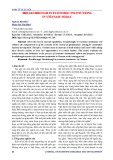

![Phát triển kinh tế ban đêm: Tổng quan vấn đề lý luận và thực tiễn [Mới nhất]](https://cdn.tailieu.vn/images/document/thumbnail/2025/20250123/tuetuebinhan000/135x160/5551737632567.jpg)
